What is £120 plus VAT?

Demystifying the Numbers: Understanding £120 Plus VAT “£120 plus VAT” – a seemingly straightforward phrase that can suddenly become puzzling when it comes to calculating the actual cost. Whether you’re a business owner dealing with invoices, a consumer making informed purchases, or simply navigating everyday financial transactions, understanding VAT (Value Added Tax) is crucial to avoid confusion and ensure accurate budgeting. This blog post delves into the intricacies of adding VAT to a £120 price tag, equipping you with the knowledge to confidently handle these calculations. We’ll explore the concept of VAT, the standard rate in the UK, and guide you through various methods to determine the final price, including formulas, online calculators, and real-world examples. Unpacking VAT: What is it and Why Does it Matter? Value Added Tax, or VAT, is an indirect tax levied on most goods and services sold in the UK. It’s essentially a “tax on a tax,” added at each stage of a product’s journey from production to the final consumer. While businesses collect VAT from customers, they only remit the difference between the VAT they collect and the VAT they pay on their own purchases to HMRC (HM Revenue & Customs). The current standard VAT rate in the UK is 20%. This means that for every £100 worth of goods or services, an additional £20 is added as VAT. Understanding this basic principle is the foundation for calculating how much £120 plus VAT actually costs. Adding VAT the Right Way: Exploring Different Methods Now, let’s explore the actual calculations. Here are three convenient ways to determine the final price of £120 plus VAT: 1. Manual Calculation: This method involves a simple multiplication. Remember, the standard VAT rate is 20%, so to find the VAT amount, multiply £120 by 20/100: Next, add the VAT amount to the original price to arrive at the final cost: 2. Formula-based Approach: For those who prefer formulas, a handy equation can be used: Plugging in our values: 3. Online VAT Calculators: The internet offers a plethora of free and user-friendly VAT calculators. Simply enter the price excluding VAT (£120) and the VAT rate (20%), and the calculator will instantly deliver the final price (£144) and the VAT amount (£24). Real-world Scenarios: Putting Your Knowledge into Practice Understanding how to calculate £120 plus VAT comes in handy in various everyday situations: Beyond the Numbers: Additional Tips and Resources Navigating the world of VAT is more than just calculations. Here are some additional tips and resources to stay informed: Conclusion: Empowering Yourself with VAT Knowledge Understanding how to calculate £120 plus VAT might seem like a small detail, but it empowers you to make informed financial decisions. Whether you’re a business owner, a consumer, or simply curious about everyday transactions, this knowledge arms you with valuable financial literacy. So, remember, the next time you encounter the phrase “£120 plus VAT,” you’ll be equipped to confidently navigate the numbers and arrive at the accurate final price. By taking the time to understand VAT, you can unlock a level of financial clarity and empower yourself to make informed decisions when it comes to your budgeting and spending. I hope this blog post has been informative and helpful. If you have any further questions or require additional clarification, please feel ALSO READ VAT cash accounting scheme 2023
Flat Rate VAT Scheme 2024 and Fixed Assets
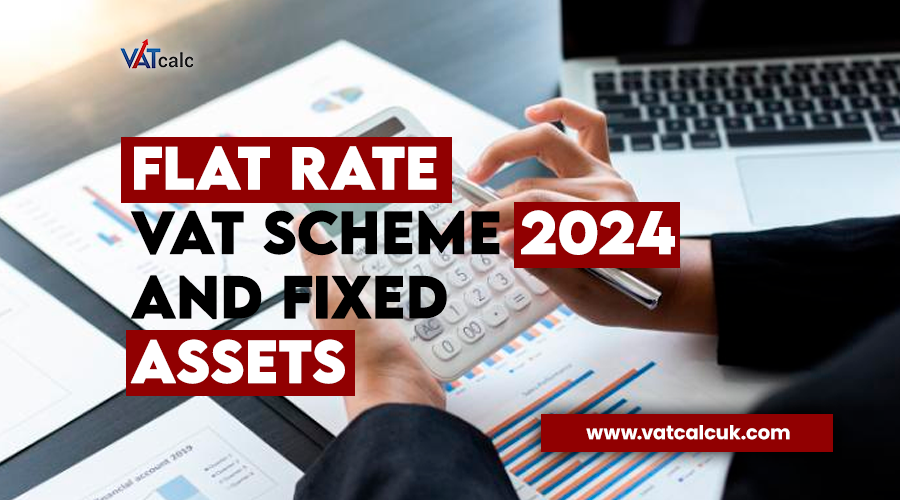
Flat Rate VAT Scheme 2024: Introduction The Flat Rate VAT Scheme and Fixed Assets play vital roles in the financial management of businesses. Understanding the interaction between these two aspects is crucial for businesses to optimize their tax strategies and asset management. What is the Flat Rate VAT Scheme? The Flat Rate VAT Scheme is a simplified method of calculating VAT for small businesses. Under this scheme, businesses pay a fixed percentage of their gross turnover as VAT to HM Revenue and Customs (HMRC), rather than calculating VAT on each sale or purchase. This scheme provides several benefits for small businesses, such as: What are Fixed Assets? On the other hand, fixed assets are long-term resources that businesses use to generate income, such as buildings, machinery, vehicles, or equipment. Effective management of fixed assets is crucial for businesses to ensure operational efficiency and maximize profitability. Understanding the interaction between the Flat Rate VAT Scheme and Fixed Assets is essential because it affects how businesses handle VAT on their asset transactions. It determines how VAT is calculated when purchasing or selling fixed assets and impacts the ability to reclaim input tax. In the following sections, we will explore the dynamics between the Flat Rate VAT Scheme and Fixed Assets in more detail. We will discuss the eligibility criteria for joining the scheme, explain what fixed assets are, and examine different scenarios that arise when dealing with fixed assets under the scheme. Additionally, we will highlight the benefits and challenges that businesses may encounter when managing fixed assets within the Flat Rate VAT Scheme. By gaining a comprehensive understanding of these interactions, businesses can make informed decisions about their tax strategies and effectively manage their fixed assets. Let’s dive deeper into each aspect to uncover valuable insights for your business. 1. Understanding the Flat Rate VAT Scheme The Flat Rate VAT Scheme is a simplified method of accounting for VAT (Value Added Tax) designed for small businesses. Under this scheme, instead of calculating VAT on each sale and purchase, businesses apply a fixed flat rate percentage to their turnover to determine their VAT liability. Here are the key points to understand about the Flat Rate VAT Scheme: Comprehensive Explanation The scheme simplifies the VAT calculation process by using a predetermined flat rate percentage. This percentage varies depending on the business sector in which the company operates. It takes into account both the standard rate of VAT and the applicable reduced rates. Benefits for Small Businesses The Flat Rate VAT Scheme offers several advantages for small businesses: Eligibility Criteria To join the Flat Rate VAT Scheme, businesses must meet certain eligibility criteria set by HMRC (Her Majesty’s Revenue and Customs). These criteria include: Understanding how the Flat Rate VAT Scheme works is crucial for small businesses as it can simplify their VAT accounting processes and potentially reduce their overall tax liabilities. By applying a fixed flat rate percentage to their turnover, businesses can streamline their accounting practices while still meeting their tax obligations. 2. Understanding Fixed Assets Fixed assets are resources that a business owns and uses to generate income over a long time. They are not meant to be sold regularly and are expected to provide value to the organization in the long run. Examples of fixed assets include: Why Effective Fixed Asset Management Matters Managing fixed assets well is important for businesses because: Key Aspects of Fixed Asset Management To manage fixed assets properly, businesses should set up strong systems and ways of doing things for: By managing fixed assets well, businesses can use them better, control costs, and make smart choices that help them succeed for a long time. Interaction between the Flat Rate VAT Scheme and Fixed Assets 2.1. Impact on fixed asset purchases below £2,000 (VAT-inclusive value) When it comes to fixed asset purchases below £2,000 with a VAT-inclusive value, the Flat Rate VAT Scheme offers a simplified method for calculating VAT. Under this scheme, businesses are not required to calculate the exact amount of VAT paid on individual purchases. Instead, they apply a fixed flat rate percentage to their gross turnover to determine the VAT owed to HMRC. This means that businesses can easily calculate their VAT liability without having to track and record the specific VAT amounts for each qualifying purchase. Example: Let’s say a small consultancy firm purchases office furniture for £1,500, including VAT. With the Flat Rate Scheme in place at a 12% flat rate for business services, the business can simply apply the 12% flat rate to its gross turnover without needing to calculate the specific input tax on the furniture purchase. This simplified approach significantly reduces the administrative burden of tracking and recording input tax on individual fixed asset purchases below £2,000. It provides small businesses with a streamlined method for managing their VAT obligations while benefiting from potential savings through the scheme’s flat rate percentages. By leveraging this simplified calculation method, businesses can allocate more time and resources to core operational activities instead of intricate VAT calculations. However, it’s essential for businesses to accurately determine which assets qualify under this threshold and ensure compliance with HMRC guidelines regarding eligible purchases under the Flat Rate VAT Scheme. In summary, for fixed asset purchases below £2,000 (VAT-inclusive value), the Flat Rate Scheme offers businesses a straightforward and efficient approach to VAT calculation, reducing administrative complexities and allowing for greater focus on business operations. 2.2. Impact on fixed asset purchases above £2,000 (VAT-inclusive value) When it comes to fixed asset purchases above £2,000 under the Flat Rate VAT Scheme, businesses encounter potential challenges that require careful consideration. Navigating these challenges effectively is crucial for businesses utilizing the Flat Rate VAT Scheme for managing their fixed assets. By understanding the implications and planning accordingly, businesses can optimize their VAT position and mitigate potential drawbacks associated with higher-value fixed asset purchases under the scheme. 2.3. Treatment of sales of fixed assets within the flat rate scheme The treatment of sales of fixed assets within the
Tax-free shopping for international visitors

A Guide to Tax-Free Shopping for International Visitors Traveling the world isn’t just about soaking in new sights and cultures – it’s also a prime opportunity to indulge in some retail therapy! And what better way to sweeten the deal than by reclaiming the taxes you pay on your purchases? Enter the glorious world of tax-free shopping, a traveler’s secret weapon for maximizing savings and snagging incredible bargains. But navigating the intricate web of tax-free schemes can be tricky, especially with ever-evolving regulations and policies. This comprehensive guide will equip you with the knowledge and tools to conquer tax-free shopping like a seasoned pro, regardless of your chosen destination. What is Tax-Free Shopping? In a nutshell, tax-free shopping allows non-resident visitors to claim a refund on the Value Added Tax (VAT) or Goods and Services Tax (GST) they pay on their purchases. This means you essentially buy at the local price minus the tax, significantly reducing your total expenditure. Sounds too good to be true? Don’t worry, it’s perfectly legal and widely popular amongst savvy globe-trotters. Who Qualifies? The eligibility criteria for tax-free shopping vary depending on the country you’re visiting. Generally, you must be: Where can I Shop Tax-Free? The good news is, that tax-free shopping opportunities abound! Popular destinations include: How Do I Claim My Tax Refund? Here’s the step-by-step process for claiming your tax refund: Top Tips for Tax-Free Shopping Success: Beyond VAT Refunds: Remember, tax-free shopping isn’t limited to VAT or GST refunds. Some countries offer additional schemes like duty-free allowances for alcohol and tobacco, making your shopping spree even more rewarding. Embrace the Thrill of Tax-Free Shopping! By following these tips and staying informed about the latest regulations, you can unlock a world of tax-free savings and make your international shopping adventures even more memorable. So, pack your bags, unleash your inner shopaholic, and conquer the world of tax-free retail therapy! Associated Links: ALSO READ UK Business Tax Year Dates & Deadlines for 2023/24
Guide to Halifax Remortgage Rates in 2024
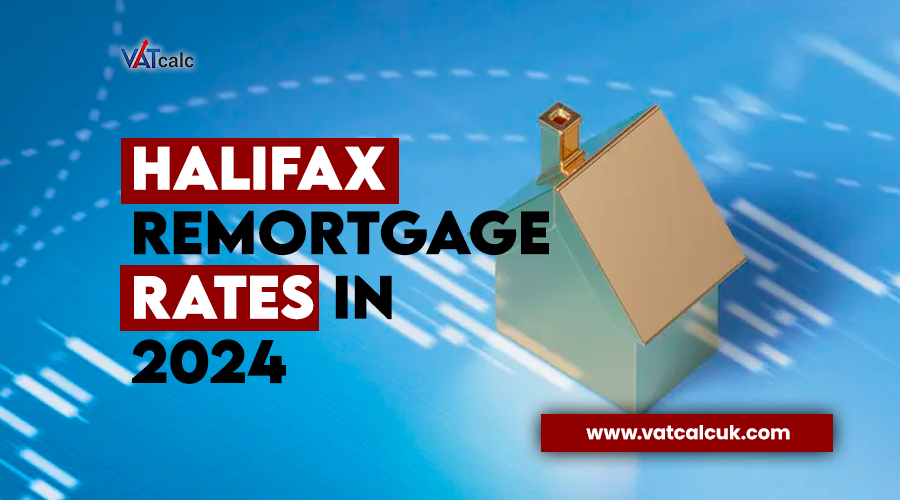
Guide to Halifax Remortgage Rates in 2024: In the ever-evolving landscape of real estate and finance, understanding the intricacies of mortgage rates is paramount for homeowners. Halifax, a prominent player in the UK mortgage market, has been a go-to choice for many. As we step into 2024, this blog aims to provide an in-depth analysis of Halifax remortgage rates. We’ll explore the factors influencing these rates, how they compare to the broader market, and what potential borrowers should consider when contemplating a remortgage. I. Understanding Halifax: A Brief Overview Halifax, part of the Lloyds Banking Group, has been a cornerstone of the UK mortgage market for decades. Known for its competitive rates and customer-centric approach, Halifax offers a variety of mortgage products, including remortgages. As of 2024, the lending landscape has witnessed changes influenced by economic factors, regulatory shifts, and market trends. II. Factors Influencing Remortgage Rates III. Halfax Remortgage Rates in 2024: A Comparative Analysis IV. Case Studies: Real Stories, Real Rates To provide a practical perspective, this section will feature case studies of individuals who have recently remortgaged with Halifax. Examining their financial situations, goals, and the rates they secured will offer readers valuable insights into the real-world application of Halifax’s offerings. V. Navigating the Application Process Understanding remortgage rates is just one part of the journey. This section will guide readers through the application process with Halifax. From eligibility criteria to required documentation, a step-by-step breakdown will empower borrowers to navigate the process seamlessly. VI. Future Trends: What to Expect Beyond 2024 The mortgage landscape is dynamic, and anticipating future trends is crucial. In this section, we will explore potential shifts in interest rates, regulatory changes, and market dynamics that may impactremortgage rates beyond 2024. VII. Expert Opinions and Advice To provide a holistic view, this section will include insights from financial experts, mortgage advisors, and industry analysts. Their opinions on the current state of the market, predictions for the future, and advice for potential remortgagers will add depth to the reader’s understanding. VIII. Frequently Asked Questions (FAQs) This comprehensive guide will address common queries and concerns related to remortgage rates. From understanding the implications of a rate change to clarifying terms and conditions, this section aims to leave no stone unturned. Conclusion: In conclusion, navigating the remortgage landscape in 2024 requires a deep understanding of economic factors, lender-specific policies, and market trends. This blog aims to equip readers with the knowledge needed to make informed decisions about their financial future. By exploring real case studies, providing practical guidance, and offering insights from experts, we hope to empower individuals on their journey toward securing the best possible remortgage rates with Halifax. ALSO READ Understanding The Implications Of The Children’s Clothing
Key dates for small business owners in 2024
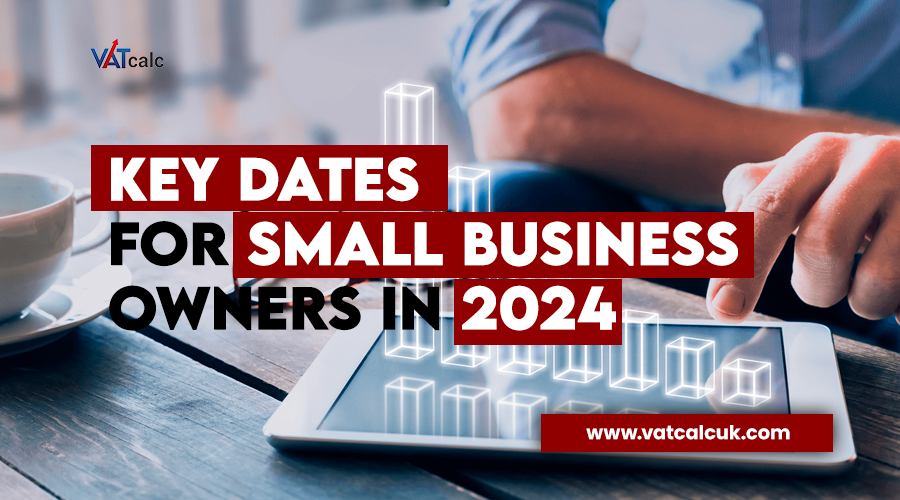
Key dates for small business owners: In the dynamic world of entrepreneurship, staying ahead of the curve is crucial for small business owners. To assist you in planning and strategizing for a successful year, we have compiled a comprehensive guide outlining the key dates for small business owners in 2024. From tax deadlines to industry events, this roadmap will help you navigate the business landscape with confidence. Let’s dive into the essential dates and events that could shape your business journey in the coming year. January: February: March: April: May: June: July: August: September: October: November: December: Conclusion: As a small business owner, staying informed about key dates and events is crucial for effective planning and successful operations. By incorporating these key dates into your business calendar, you can navigate the year 2024 with confidence. Remember to stay adaptable and responsive to industry changes, and use these dates as a foundation for building a prosperous and resilient business. For more information and resources, you can visit official websites such as the Internal Revenue Service (IRS) at www.irs.gov and the Small Business Administration (SBA) at www.sba.gov. Stay tuned for updates and additional insights throughout the year to ensure your small business thrives in 2024. ALSO READ Understanding The VAT Threshold Changes In The UK For 2024
Norway VAT Changes in 2024
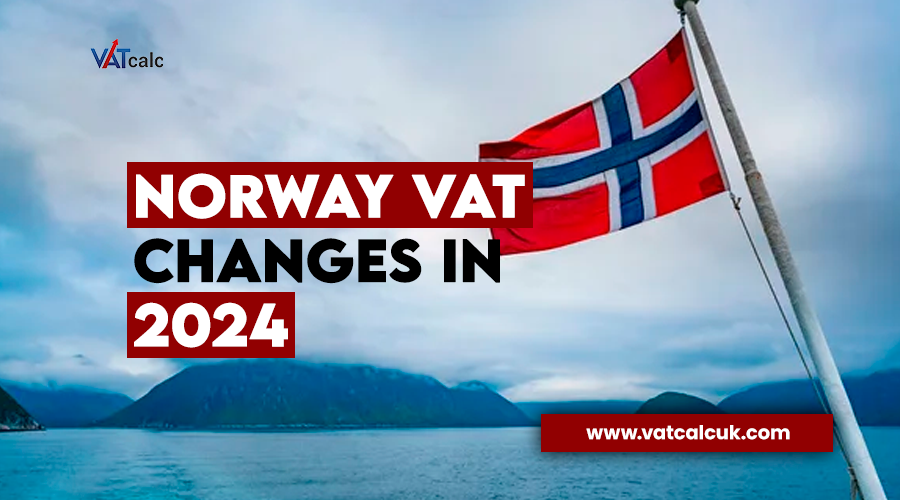
Navigating Norway’s VAT Changes in 2024 In 2024, Norway is set to implement significant changes to its Value Added Tax (VAT) system, bringing about a series of reforms that will impact businesses and consumers alike. These changes aim to enhance the efficiency and fairness of the VAT system while aligning with the evolving economic landscape. In this comprehensive guide, we will delve into the details of Norway’s VAT changes, exploring the key amendments, their implications, and providing essential information for businesses and individuals. Table of Contents: Conclusion: In conclusion, Norway’s VAT changes in 2024 represent a significant milestone in the country’s economic policy. While these changes may pose initial challenges for businesses and individuals, understanding the intricacies of the new VAT system is crucial for successful adaptation. By staying informed, leveraging available resources, and seeking professional advice, businesses can navigate these changes effectively, ensuring compliance and contributing to a more transparent and equitable economic environment. For the latest and most accurate information, it is recommended to refer to official government websites and consult with legal and financial experts. Stay tuned for updates on Norway’s VAT changes as the country moves forward with its commitment to a modern and efficient taxation system. Official Websites for Reference: Also Read Understanding VAT Calculation In UK- Complete Guide 2023
Use The 2024 Retail Calendar As Your Roadmap
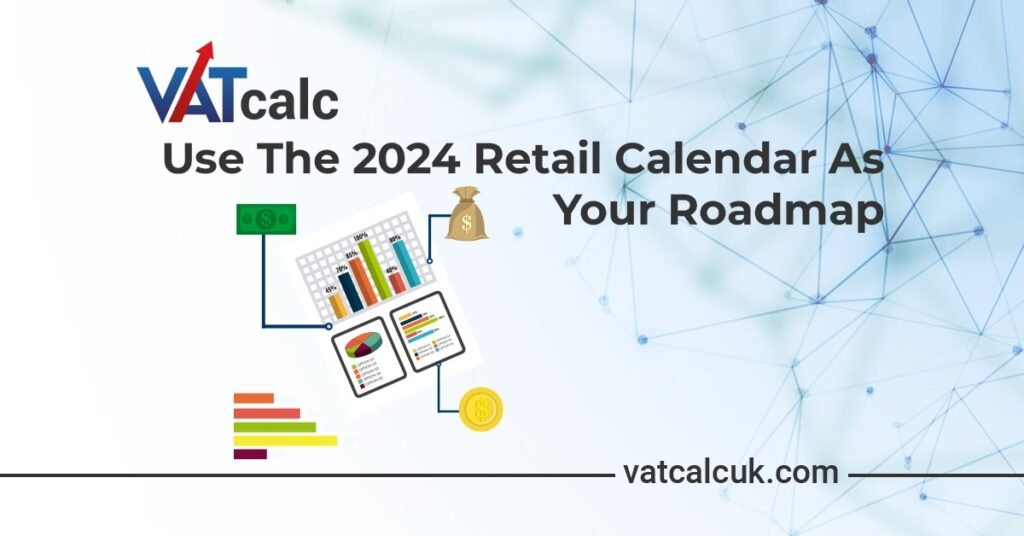
2024 Retail Calendar: In the ever-evolving world of retail, staying ahead of the curve is crucial for success. As we step into the year 2024, retailers need a roadmap to guide them through the various challenges and opportunities that lie ahead. Fortunately, the 2024 Retail Calendar provides an invaluable tool for businesses to plan, strategize, and optimize their operations. In this comprehensive guide, we will delve into the key aspects of the 2024 Retail Calendar, exploring important dates, trends, and strategies to help retailers thrive in the upcoming year. Understanding the 2024 Retail Calendar The retail calendar is a dynamic tool that outlines significant events, holidays, and sales periods throughout the year. It serves as a roadmap for retailers to plan their marketing campaigns, promotions, and inventory management effectively. Let’s break down the 2024 Retail Calendar to understand the critical milestones that can impact your business. As the year begins, retailers should seize the opportunity to capitalize on the New Year’s enthusiasm. Implementing post-holiday promotions, clearance sales, and targeted marketing campaigns can help kickstart the year on a positive note. Valentine’s Day remains a significant shopping event, with consumers eager to express their love through gifts. Retailers can tailor promotions and create themed displays to attract customers seeking the perfect gift for their loved ones. As spring arrives, consumers often engage in spring cleaning and home improvement projects. Retailers can leverage this trend by offering promotions on cleaning supplies, organization tools, and home décor. Official Link: Optimizing Spring Cleaning Sales Easter provides an excellent opportunity for retailers to attract families with themed promotions, egg hunts, and special discounts. Creating a festive atmosphere in-store and online can enhance the overall shopping experience. The midpoint of the year is an ideal time for retailers to conduct a thorough inventory review. Analyzing sales data, identifying slow-moving products, and optimizing stock levels can help streamline operations and prepare for the second half of the year. Back-to-school season is a critical period for retailers, with families shopping for clothing, school supplies, and electronics. Crafting targeted marketing campaigns and offering promotions can attract a significant customer base. Many retailers now offer Black Friday preview sales in early November to build anticipation and drive early holiday shopping. Planning enticing deals and promotions during this period can set the stage for a successful holiday season. Official Link: Black Friday Preview – Early Bird Deals The digital shopping extravaganza of Cyber Monday has become a global phenomenon. Retailers must optimize their online platforms, enhance cybersecurity measures, and offer compelling online deals to capture the attention of digital-savvy consumers. Official Link: Cyber Monday Retail Insights Conclusion The 2024 Retail Calendar serves as a comprehensive roadmap for retailers to navigate the ever-changing landscape of the industry. By strategically aligning marketing efforts, promotions, and inventory management with key dates and trends, businesses can position themselves for success in the coming year. As you embark on your retail journey in 2024, refer to this guide and the official links provided to stay informed and make data-driven decisions that will drive your business forward. Happy retailing! ALSO READ The VAT Threshold Changes In The UK For 2024
January 2024 global VAT and GST rises
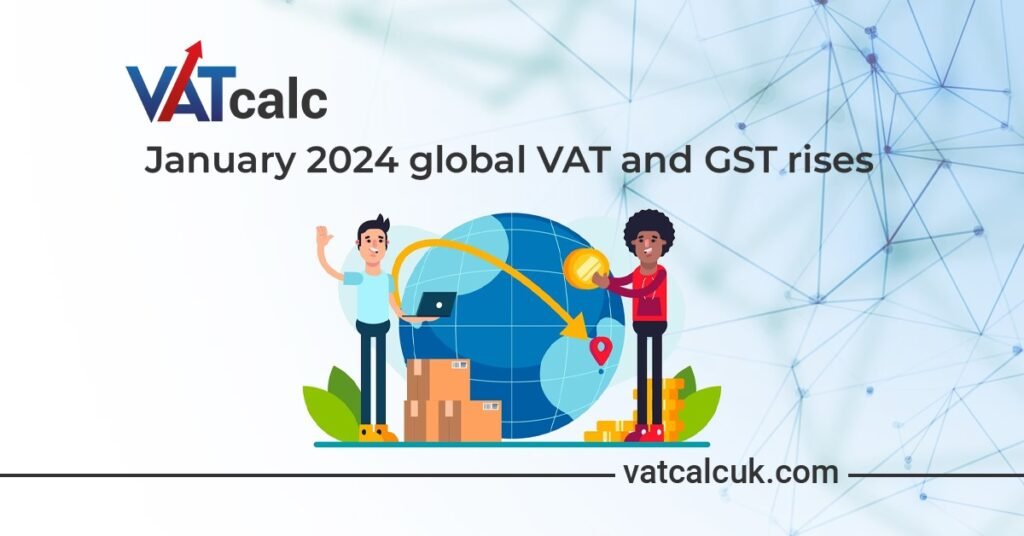
Global VAT and GST Rises: In January 2024, the global business landscape experienced a significant shift as several countries implemented changes to their Value Added Tax (VAT) and Goods and Services Tax (GST) rates. These alterations have far-reaching implications for businesses operating on an international scale. In this comprehensive guide, we will delve into the details of the VAT and GST increases, explore the reasons behind these changes, and provide insights on how businesses can adapt to the new tax landscape. Understanding VAT and GST Before we delve into the specifics of the January 2024 changes, let’s establish a foundational understanding of VAT and GST. Value Added Tax (VAT) and Goods and Services Tax (GST) are consumption taxes typically levied at each stage of the production and distribution chain. They are indirect taxes, meaning that the end consumer ultimately bears them. VAT and GST rates vary from country to country, and the revenue generated is an essential source of income for governments worldwide. The adjustments made to these rates can have profound effects on businesses and consumers alike. VAT and Global GST Rises in January 2024 Reasons Behind the Changes Adapting to the New Tax Landscape Conclusion The January 2024 VAT and GST rises have reshaped the international business environment. As businesses navigate these changes, staying informed and proactive is key to maintaining financial stability and compliance. By understanding the reasons behind the adjustments and implementing strategic adaptations, businesses can position themselves for success in the evolving marketplace. Also Read How Does VAT (Value Added Tax) Work?
Second-hand vehicle VAT Margin Scheme – extension
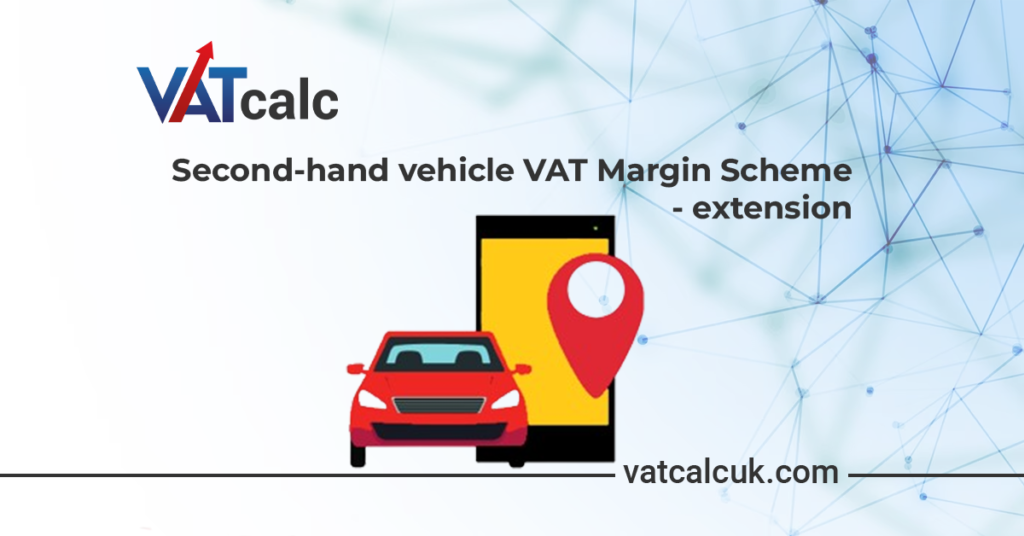
Second-hand Vehicle VAT Margin Scheme In the ever-evolving landscape of taxation, one area that demands the attention of businesses engaged in the sale of second-hand vehicles is the Second-Hand Vehicle VAT Margin Scheme. This scheme, designed to streamline the tax process for used vehicle transactions, has recently undergone an extension, introducing a series of nuanced changes that warrant a detailed examination. This blog post aims to unravel the intricacies of the extended Second-Hand Vehicle VAT Margin Scheme, offering a comprehensive guide to help businesses and individuals alike navigate these uncharted waters. Understanding the Foundation: The Second-Hand Vehicle VAT Margin Scheme, a stalwart in the automotive industry, has played a pivotal role in mitigating the tax burden associated with the sale of pre-owned vehicles. At its core, the scheme allows businesses to calculate VAT based only on the profit margin of the sale, a departure from the conventional method of applying VAT to the entire selling price. This nuanced approach seeks to strike a balance, preventing double taxation on second-hand vehicles and fostering a fair environment for both buyers and sellers. Extension Overview: The extension of the Second-Hand Vehicle VAT Margin Scheme brings about a shift in the dynamics of how businesses in this sector must approach their tax obligations. To comprehend the full scope of these changes, it is imperative to delve into the specifics of the extension. 1. Duration and Applicability:The first point of consideration is the duration of the extension. Businesses must be cognizant of the timeframe during which the extended scheme is applicable to align their operations and strategies accordingly. A thorough understanding of this temporal aspect is crucial for seamless compliance. Official Link: HM Revenue & Customs – Second-Hand Margin Scheme 2. Compliance Requirements:As with any extension, updated compliance requirements come into play. Businesses operating under the extended Second-Hand Vehicle VAT Margin Scheme must meticulously document transactions, ensure accurate calculation of VAT margins, and adhere to the stipulated deadlines for the submission of VAT returns. Failure to comply may result in penalties and legal consequences. Official Link: VAT Notice 718 – Margin Scheme for second-hand goods 3. Impact on Pricing Strategies:The extension necessitates a reevaluation of pricing strategies. Businesses must analyze the financial implications of the changes and consider how adjustments may impact customer behavior and market competitiveness. Striking a balance between profitability and customer satisfaction becomes a delicate art in this altered landscape. Official Link: VAT guide (VAT Notice 700) 4. Stakeholder Education:Proactive communication is paramount. Businesses must embark on an educational campaign to inform and educate stakeholders, including employees, customers, and suppliers, about the nuances introduced by the extension. This transparent approach facilitates a smoother transition and ensures that all parties involved are well-informed. Official Link: HM Revenue & Customs – VAT 5. Seeking Professional Advice:Recognizing the complexity of tax regulations, businesses are strongly encouraged to seek professional advice from tax consultants or accountants. These experts can provide invaluable insights into the intricacies of the extended scheme, ensuring not only compliance but also the maximization of benefits. Official Link: Find a tax adviser or accountant Conclusion: As businesses embark on the journey through the extended Second-Hand Vehicle VAT Margin Scheme, adaptability and informed decision-making will be their compass. By staying abreast of the changes, adhering to compliance requirements, and strategically adjusting pricing and communication strategies, businesses can not only weather the challenges but also position themselves for sustained success in this dynamic marketplace. ALSO READ VAT Margin Scheme 2023
VAT margin schemes for years ending in 2024

VAT Margin Schemes: As the calendar turns to 2024, businesses engaged in the resale of second-hand goods find themselves once again at the intersection of commerce and taxation. At the heart of this juncture lies the VAT Margin Schemes, a nuanced framework designed to streamline VAT calculations for businesses dealing in second-hand items, from antiques to pre-loved artifacts. In this extensive blog post, we will embark on a detailed exploration of the VAT Margin Schemes, shedding light on its intricacies and the notable changes that businesses need to be aware of in the year 2024. Understanding the VAT Margin Scheme: The VAT Margin Scheme is a distinctive taxation mechanism applied to businesses involved in the resale of certain goods. Rather than imposing VAT on the entire selling price, the scheme mandates that VAT be levied solely on the profit margin – the difference between the purchase and selling prices. This approach aims to alleviate the tax burden on businesses trading in second-hand commodities. Key Features of the VAT Margin Scheme: Changes in 2024: To stay ahead of the curve, businesses must be aware of any changes or amendments to tax regulations. In 2024, specific adjustments to the VAT Margin Scheme may have been introduced, impacting businesses in this sector. To obtain the most accurate and up-to-date information, businesses are strongly advised to refer to official government sources. Official Links and Resources: Conclusion: In conclusion, the VAT Margin Schemes for the year ending 2024 demand a meticulous understanding of its complexities. By staying abreast of changes through official channels such as HMRC and VAT notices, businesses can effectively ensure compliance and leverage the scheme’s benefits. Given the intricate nature of tax regulations, seeking professional advice is advisable to navigate specific circumstances. Regular checks on official resources and a proactive approach to compliance will empower businesses to thrive within the dynamic landscape of the VAT Margin Schemes. VAT Margin Scheme 2023
